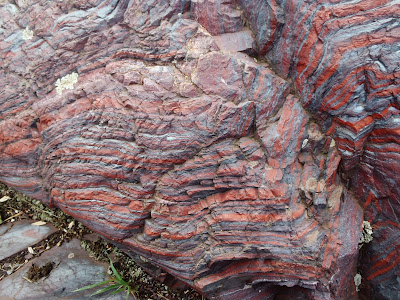Sunday, April 14, 2013
Banded Iron Formations BIF
Banded Iron Formations are so awesome, and they are my favorite rock deposits in all of Earth History. In the Fall of 2012 I took a Rocks and Minerals class here at Northern. This is by far my favorite class in my college career so far. Every Friday my class, which consisted of about 8 students, and my awesome, chill professor, would hop in a van and cruise all around Marquette county studying rock formations that date back to 3 billion years ago. Oh my Gaia, it was so much fun! Anyways, with this class we also had an Academic Service Learning opportunity. The Michigan Iron Industry Museum in Ishpeming has a great exhibit on the iron mining industry in the UP, but their exhibit on the geology of the iron wasn't so great. The job of my class was to provide research on Banded Iron Formations as well as the vast iron deposits of the UP region. The type of environment they were deposited in, what minerals make up this formation, and concerning the BIF's; how the beautifully alternating layers of iron rich (dark) layers and iron poor, silica-rich Jasper (red) layers were deposited, were questions we were looking to answer. Our research revealed many theories about the deposition environment and processes of the BIF's. The most accepted was, during the Early Pre-Cambrian time period, 3 billion years ago, the Archean Eon, the atmosphere contained little to no free-oxygen and consisted mainly of methane and carbon dioxide, very different from today's environment. There were also vast seas that occupied the Lake Superior Region (Michigan, Wisconsin, Minnesota), within these seas there were iron minerals "floating" around, because the atmosphere and the seas were oxygen depleted, they were not able to deposit. However, after another million years during the Proterozoic, the atmosphere changed to an oxygen rich zone. How did this happen? Scientists believe its because of cyanobacteria, early photosynthetic organisms that convert sunlight to oxygen. BIF's are evidence of Mother Earth's early life!! Once oxygen levels increased, the iron and silica ions within the seas would combine with the free-oxygen to form magnetite and iron-oxide. Why the minerals were deposited in alternation layers is still being debated among the scientific community, some say its because of seasons, while others believe multiple extinctions of the photosynthetic organisms led to accumulation of the iron poor minerals, and when the organisms re-established themselves, the iron-rich layers could then be deposited. What we do know is deposition lasted millions of years, then abruptly stopped during the Proterozoic and is not seen anywhere else in Earth's geologic history. A new discovery of a meteorite that struck Earth, Sudbury, Ontario to be exact, is believed to be the culprit for the end of BIF deposition. Sudbury, Ontario is just north of the Lake Superior Region, so the impact had an enormous effect on the current environment, there are actually remnants of the impact about 10 minutes from downtown Marquette. The impact was so large that it changed the chemistry of the seas, which is thought to have stopped the BIF deposition This is just a theory but the timing of the impact is pretty ironic to the end of the deposition.
BIFs are not only a beautiful rock to look at but they also are the story of Earth when she was very young. It's like finding a drawing you created when you were 3 years old, or a home video of you at young age that you completely forgot about. These creations reveal who you were at that age, and though the period seems very vague at the present time, finding these memories and past events reopen feelings and reminders of who you were in the past, it's similar to opening a time capsule. Nature holds the secrets of Earth's history, discovering this history is not only magical but also important to discovering the future.
Subscribe to:
Post Comments (Atom)


No comments:
Post a Comment